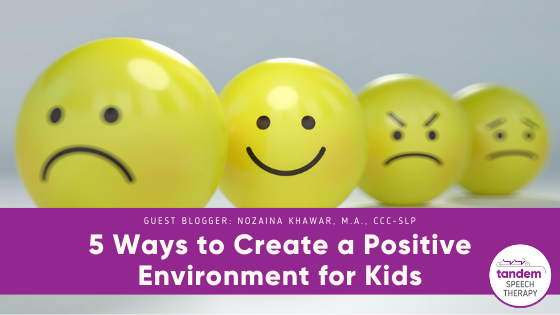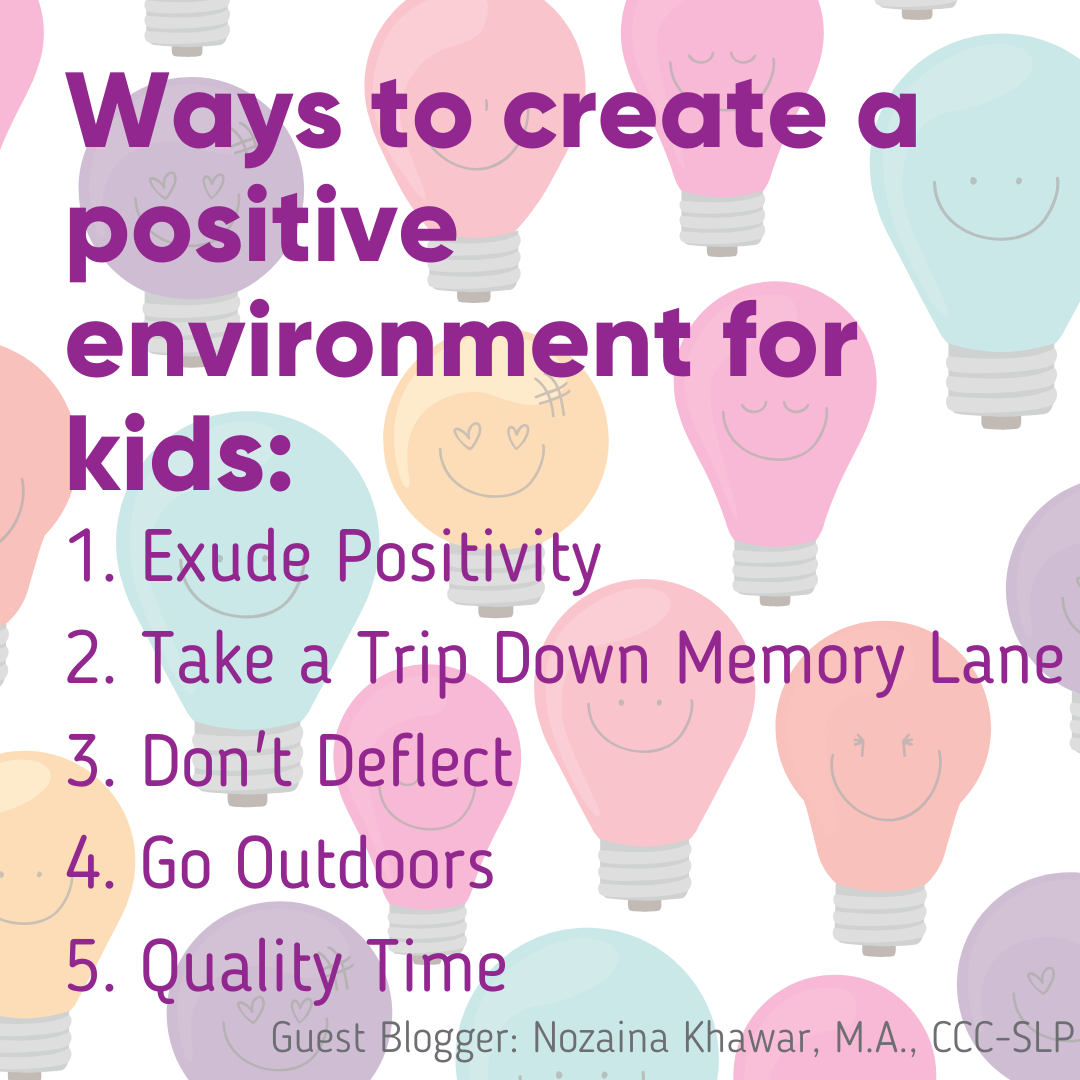
This week I welcome Nozaina Khawar, M.A., CCC-SLP of Empowered Speech Therapy, a speech therapy telepractice, as a guest blogger for Tandem Speech Therapy.
We all know that one person who lights up a room as soon as they walk in. On the contrary, we also know a Debbie Downer or a Negative Nick (#genderinclusivity). I am a firm believer that we all exude a certain type of energy and the energy we emit is highly contagious. Simply put, our emotions are contagious and we have the power to either uplift someone or make them feel crummy without them even realizing why they feel that way. A study on happiness found that people’s happiness is dependent on the happiness of those they are connected to, thus, seeing happiness and health as a collective phenomenon (Christakis & Fowler, 2008). Inevitably our happiness and emotions end up rubbing off on those closest to us, specifically, our children.
The past few months have undoubtedly had an impact on the entire world and have been nothing short of an emotional roller coaster. As we try to navigate through the changes, it can be easy to project our frustrations and negative feelings onto our kids without realizing the impact it has on them. Another study concluded, “positive emotions transform people for the better, giving them better lives in the future; discrete positive emotions are essential elements of optimal functioning” (Fredrickson, 2001). Therefore, for our children to reach their maximum potential and have a bright future we must surround them with positivity.
The following are 5 ways to create a positive environment for children:
1. Exude Positivity
There’s a phenomenon called emotional contagion, which is the idea that one person’s emotions trigger similar emotions in another person. According to John Y. Cacioppo, a distinguished researcher in the field of social neuroscience, “the more expressive someone is, the more likely you are to notice that expression and mimic it.” So why not exude positive emotions for our children to mimic positivity? We must become mindful of the impact our emotions and actions have on the little ones to prevent them from channeling negativity.

2. Take a Trip Down Memory Lane
Pause, close your eyes and think back to what made you happy as a child. What was that one thing that always brought you joy? Now, do that for your kid(s). Chances are if it made YOU happy, it will make them happy. For me, it was “Toys R’ Us” trips with my siblings on a $20 budget. It was so simple yet remains one of my fondest memories. Don’t underestimate the power of small gestures, it is often the “little things” that make a big difference. Focus more energy on cultivating what you want for your children rather than what you don’t want.
3. Don’t Deflect
It’s 12:50 p.m., you have a 1:00 p.m. Zoom meeting, your kid is crying in the background, you didn’t get time to squeeze in lunch, and you now have spit up on your freshly steamed shirt. At this point, it is extremely easy to turn around and scream at your kid. However, it is in that moment you must take control of your emotions because the little one may only be mimicking your emotions. So instead of deflecting your frustration, remain calm and continue to comfort the child. You will have a much higher chance of calming them and ultimately yourself as well.
4. Go Outdoors
Nature is good for the soul. It’s as simple as that. It is nourishing for the mind and body to take a break and step outside for a breath of fresh air. Not only does going outdoors encourage exercise but it also helps improve focus and reduce anxiety in children. According to research, “doses of nature might serve as a safe, inexpensive, widely accessible new tool in the tool kit of managing ADHD symptoms” (Kuo & Taylor, 2009). So go outdoors because it may just be what you and the kids need to recharge and cultivate positivity.
5. Quality Time
As a Speech-Language Pathologist, I can’t leave out the importance of spending quality time not just to create a positive environment but also to nurture speech and language development in children. That means LIMITING screen time and spending more interactive quality time to foster their growth and development. We live in extremely busy times where we have more on our to-do lists than we can manage to scratch off. Add working from home while trying to navigate homeschooling to the mix and we’re at our wits’ end. So instead of trying to juggle everything by yourself, why not turn it into group projects? Get kids to participate in home organization projects, do a cleaning race to see who can clean their area the fastest, bake a dessert together, or make a family photo album. Not only will you get some much-needed help but you will aid the development of your children in more ways than you can imagine.
Ultimately, the environment we create for our children sets the foundation for their future. Like forming any habit, learning to control our emotions requires practice and mindfulness. Giving children a positive environment helps nourish their development and that in itself is a valuable investment.
Nozaina Khawar, M.A., CCC-SLP owns a private telepractice through which she provides online speech therapy services in multiple states. She works with children and adults of all ages. She shares helpful speech & language tips and information on Instagram and Facebook. Visit www.empoweredspeechtherapy.com to book a session with her or email her at empoweredspeechtherapy@gmail.
Find Nozaina on Facebook: https://www.facebook.com/empoweredspeechtherapy
Follow Nozaina on Instagram: https://www.instagram.com/empoweredspeechtherapy/

References:
Fowler, J., & Christakis, N. (2008, December 05). Dynamic spread of happiness in a large social network: Longitudinal analysis over 20 years in the Framingham Heart Study. Retrieved June 23, 2020, from https://www.bmj.com/content/337/bmj.a2338
Fredrickson, B. (2001, March). The role of positive emotions in positive psychology. The broaden-and-build theory of positive emotions. Retrieved June 23, 2020, from https://www.ncbi.nlm.nih.gov/pmc/articles/PMC3122271/
Jodi Schulz, M. (2018, November 19). Emotions are contagious: Learn what science and research has to say about it. Retrieved June 23, 2020, from https://www.canr.msu.edu/news/emotions_are_contagious_learn_what_science_and_research_has_to_say_about_it
Taylor, A. F., & Kuo, F. E. (2008, August 25). Children With Attention Deficits Concentrate Better After Walk in the Park. Retrieved June 23, 2020, from https://pubmed.ncbi.nlm.nih.gov/18725656/
Start Playing With Purpose
Learn how to purposefully and intentionally interact with your child during play and help them increase opportunities for speech and language development with our Playing with Purpose book!










